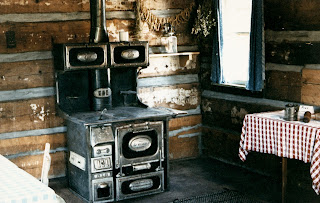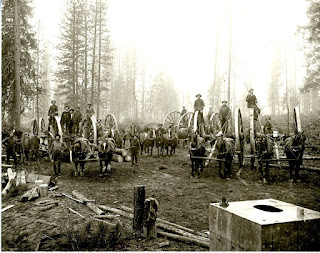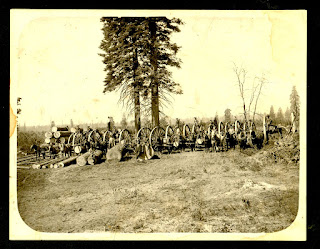The Davis Log Cabin
 |
| Henry and Henrietta Davis in front of cabin, 1860's |
The
cabin was constructed in 1856 and occupied until 1870, when a larger farmhouse
was constructed by Henry Levi Davis.
In 1852 Henry came across the plains from Ohio to California in search
of gold. By 1853 his attentions
shifted to ranching and he filed on a homestead in Little Shasta Valley. The ranch is still in the family today
(as of 2015). This cabin is
constructed of pine that was shaped with an adze. The corners are constructed using the half-dovetail notch
for strength and for shedding water.
Henry
married a neighbor, Henrietta Deter, in August of 1861. They were to have their first four
children born while living in the cabin.
After moving into the ranch house, three more children were born to the
couple.
A
side note: in later years the
cabin was used for storage in the room to the right of the door and the room to
the left was used as a bunk house for men hired to help on the ranch during the
haying season. It was used for
this purpose until it was donated to the Historical Society by Orlo and
Charlotte Davis in 1975. It is a
Point of Interest, Reg. # SIS-002.
 |
| A peek inside the cabin at the Outdoor Museum |
The Davis Ranch, Little Shasta Valley, 1854-2004
From
notes submitted by Betty Davis Carrier and Helen William Easton
Henry
Levi Davis, born in Tiffin, Ohio in 1832, came to California across country in
1852, arriving in Yreka in August of that year. After trying his hand at mining in the Humbug area and doing
carpenter work in Yreka, he decided that farming in Little Shasta Valley was to
his advantage. Later in his life
he often told his grandchildren about his first crop of grain. He said it
wasn’t doing very well because there were so many grasshoppers that year. One day he discovered the grain field
had been set afire. Upon
investigating, he found a family of Indians out in the burned field picking up
the roasted grasshoppers for food.
Because the grain crop was such a poor one, and because he was friendly
with the Indians, he did nothing about.
In 1854 Jesse F. Davis, Henry’s brother, arrived in Yreka; together they
homesteaded 280 acres in sections 4, 5 and 8. They had a temporary cabin by the spring near the present
Williams Ranch, farming off and on until 1856, when Henry built the cabin at the
present ranch site and moved there permanently. Jesse later built a cabin by Davis Gulch. Nothing remains of that cabin, but
every year to this day, hop vines return to remind us of an earlier
habitation. In 1860 Henry returned
to Ohio to purchase horses and stock for his ranch, returning the same year
with his friend, Edward Coonrod, who helped drive the livestock. The trip was very difficult because
forage was scarce and the Indian tribes were more hostile.
On
August 29, 1861 Henry married Henrietta Deter, daughter of David Deter, born in
Wayne County, Ohio, December 6, 1843.
They were married in the parlor of the Yreka Union Hotel in Yreka by
Judge A. M. Rosborough. Henrietta
crossed the plains in 1860 with her father and three brothers, settling on
David’s ranch located a mile to the west of the Davis Ranch. Henry and Henrietta settled into the
log cabin that is now located in the Siskiyou County Historical Society’s
Outdoor Museum. Their first four
children were born in this cabin: Mary Jane (Davis) -b. Feb. 4, 1863, d. 1915; Hattie
(Williams) - b. June 6, 1865, d. 1939; Emma (Kennedy) -b. Oct. 17, 1867, d.
1953; Nettie (Davis) - b. Oct. 7, 1869, d. Oct. 24, 1870. In early 1872 the family moved into the
present ranch house, where three more children were born: Isaac Shriver Davis -
b. April 17, 1872, d. 1950; Henry Levi Davis, Jr. - b. Sept. 14, 1874, d. 1908;
Dr. Fred Jay Davis - b. June 16, 1883, d. 1965.
Henry
first raised sheep on his ranch, then in the 1880’s he purchased a purebred
herd of eight Holstein cows and one bull shipped from the east to Ashland,
Oregon.
 |
| Cow and Cabin on Davis Ranch, 1930's |
They were driven over the
Siskiyou Mountains on foot, requiring several days of slow travel. At this time he also raised horses. Through the years Henry acquired more
neighboring land and two mountain ranches on Ball Mountain – First Creek and
Horsethief Meadows, making cattle ranching the main pursuit of the ranch.
Besides
being a good farmer, Henry Live Davis was an influential citizen of Little
Shasta, Montague and the community, and was a very good businessman. He was interested in the development of
the new town of Montague, resulting in acquiring or having built, a number of
properties there, including the Mitchell and Opera Saloons and the Montague
Hotel. He was one of the first
presidents of the Montague Bank, and later a bank director.
Henry
Levi, Jr., remained on the ranch to run it with his father after Isaac had
married and moved to Butte Valley, and then to Merrill, Oregon. Tragically Henry Jr. died of
appendicitis in1908 at the age of 34 years. Henry Sr. stayed at the ranch until 1911 when he retired to
Montague, passing on in 1915.
A
few years prior to his death, Henry Sr. was ill and needed medical treatment.
Henrietta accompanied her husband on the train from Montague to San Francisco,
where he was admitted to the hospital.
This hospital used coal oil lamps for some light, but then attached
candles to each wooden headboard of the patients’ beds. One night while Henry was lying in his
hospital bed, the candle caught his wooden bed afire. Henrietta started to scream, “Fire!” However, Henry, being the very modest
and proper man that he always was, firmly told her, “I will not get out of this
bed until someone brings me my pants!”
As the story goes, he stayed there with his bed burning while Henrietta
frantically got some pants for him to put on. After his recovery, they returned to their home in Montague
for a time.
In
1906, Henry became ill a second time, and he again traveled to San Francisco
and was put into the hospital. He
was a patient in that hospital when the great earthquake of 1906 hit San
Francisco. The whole city was a
havoc of destruction, confusion and fire for days. Henry and the other patients were moved to the Golden Gate
Park, where they were laid out on the grass. While he was there he watched the city burn.
Between
1911 and 1915 the ranch was leased by two grandsons, Ernest and Allen Williams,
sons of Hattie Davis Williams, but since it was the wish of Henry that the
Davis name remain on the ranch, the eldest son, Isaac, took over the ranch in
1916. Isaac had married Aldee
Coonrod, daughter of Edward and Eliza on November 24, 1897. They homesteaded in Sams Valley near
Dorris, California, and then established a ranch in Merrill, Oregon in
1899. Their eldest child,
Henrietta, was born in Sams Valley in 1898. Their second child, Edward Orlo (aka Orlo)was born at home
in Merrill on February 25, 1900, and Anna was born in 1905. In 1916 Isaac and family moved back to
the home ranch, where another son, Henry, was born November 13, 1916. Orlo, 16 years old when the move was
made, was in charge of getting the livestock to the home ranch from Merrill. Isaac and Orlo increased the tillable,
irrigated acreage of the ranch in 1920 by purchasing part of the neighboring
John Kegg ranch. In 1929 Orlo
married Charlotte Osteriech, daughter of Emil and Ida Osteriech of Doty, Washington. They had a daughter, Betty Joan, born December 18,
1932. Orlo did all the farming and
ranching at that time as Isaac had had a back injury that incapacitated him in
the 1920’s. In 1950 Isaac passed
away and Orlo, Charlotte and Aldee continued a partnership until 1970 when
Aldee passed away. Orlo was the
sole owner until he felt he wanted to retire, selling the ranch to his
daughter, Betty Davis Carrier and her husband, Jim Carrier (b. in Oil City,
Pennsylvania, May 26, 1929). They
were married November 3, 1962. Jim
pursued a career as a forester for the U. S. Forest Service for 27 hears.
Orlo
Davis passed away in 1990 at the age of 90. He spent 74 years on the Davis Ranch improving production of
his cow-calf operation, running 250 head of top quality animals. He was named Siskiyou Cattleman of the
Year in 1971. He semi-retired at
the age of 78, but continued an active interest in the ranch until his death on
August 3, 1990.
Jim
and Betty Carrier and sons John, (b. Feb. 27, 1967) and Mark (b. December 28,
1968) moved back to the ranch in June of 1983. They totally remodeled the original ranch house that was
built in 1871-72. Jim was working for
the U.S. F.S. on the Klamath National Forest at the time, and gradually started
a small herd of cows. He retired
from the Forest Service at the end of 1986, and continued to raise cows and hay
until 1994 when he decided to retire from ranching. The Carriers have now leased the acreage to the Brice Martin
family, neighboring ranchers. When
Orlo died in 1990, Charlotte remained on the ranch until 1992, when she moved to
Yreka to be closer to her social activities. She was contented to spend her days in Yreka until early
2002, when she was no longer able to care for herself. She spent her last 10 months in the
Grenada Inn, passing away on January 14, 2003. Jim and Betty continue to live on the ranch and enjoy their
retirement. The boys plan to
return someday when their careers slow down.

 Prior
to the 1870's, logging was performed by the grueling process of dragging logs
from the woods with bull teams. In 1875, Silas Overpak of Manistee, Michigan,
introduced a wheeled device from which logs could be suspended, making the work
of bulls or horses greatly easier in moving logs to mills or landings.
Overpak's Michigan Big Wheels won an award at the 1893 Chicago World's Fair, and
logging was changed forever.
Prior
to the 1870's, logging was performed by the grueling process of dragging logs
from the woods with bull teams. In 1875, Silas Overpak of Manistee, Michigan,
introduced a wheeled device from which logs could be suspended, making the work
of bulls or horses greatly easier in moving logs to mills or landings.
Overpak's Michigan Big Wheels won an award at the 1893 Chicago World's Fair, and
logging was changed forever.














